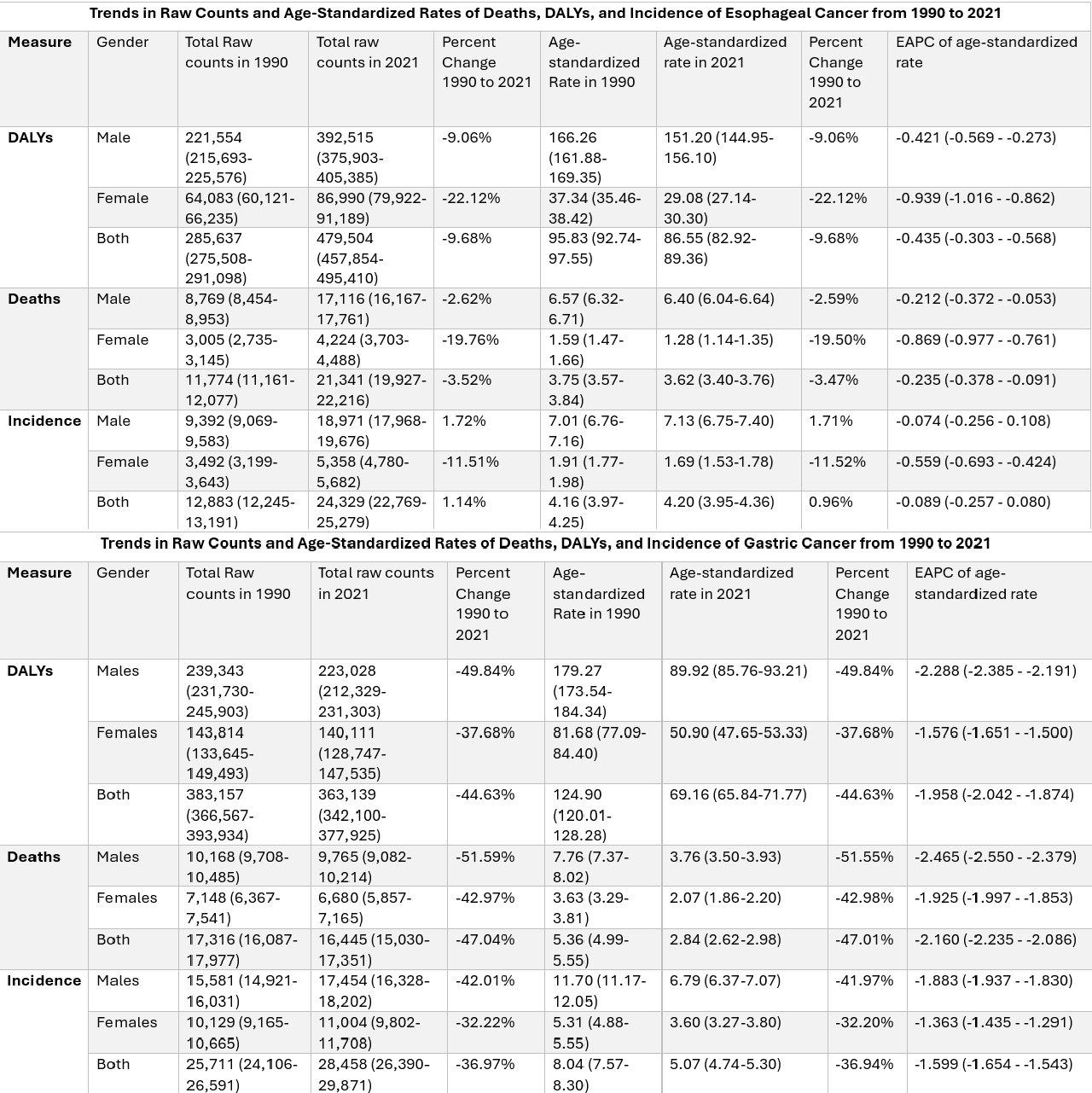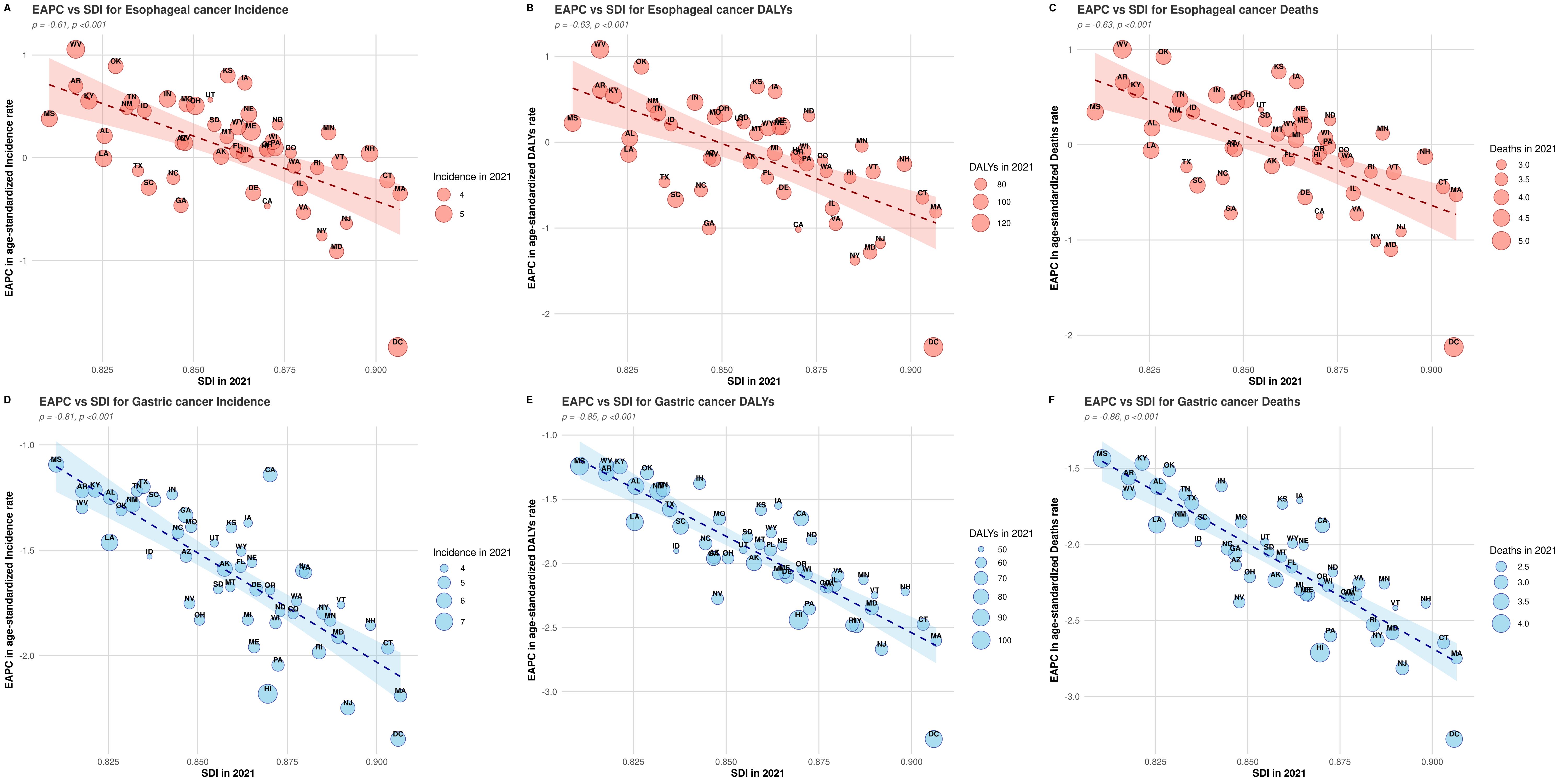Tuesday Poster Session
Category: Esophagus
P4896 - Temporal Trends and Geographic Disparities in Upper Gastrointestinal Cancer Burden in the United States: A Nationwide Analysis Over 3 Decades
Tuesday, October 28, 2025
10:30 AM - 4:00 PM PDT
Location: Exhibit Hall
- OA
Omar Al Ta'ani, MD
Department of Internal Medicine, Allegheny Health Network, Pittsburgh, Pennsylvania, USA
Pittsburgh, PA
Presenting Author(s)
Omar Al Ta’ani, MD1, Rahul Karna, MD2, Yahya Alhalalmeh, MD3, Jonathan Ghobrial, MD4, Rafi Iftekhar, MD5, Max Jin, MD6, Mohammad Bilal, MD, FACG7
1Department of Internal Medicine, Allegheny Health Network, Pittsburgh, Pennsylvania, USA, Pittsburgh, PA; 2University of Minnesota Medical Center, Minneapolis, MN; 3New York Medical College - Saint Michael's Medical Center, Newark, NJ; 4Allegheny Health Network Medicine Institute, Pittsburgh, PA; 5Ballad Health - Richmond, VA UNITED STATES - Richmond, VA, Norton, VA; 6Allegheny Health Network, Pittsburgh, PA; 7University of Colorado Anschutz Medical Campus, Denver, CO
Introduction: Upper gastrointestinal (UGI) cancers, including esophageal and gastric malignancies, remain major contributors to morbidity and mortality in the United States (US). Despite advances in care, disparities in disease burden persist, highlighting the need to understand temporal trends, geographic variation, and sociodemographic factors. We aim to conduct a retrospective study using the Global Burden of Disease (GBD) 2021 dataset to assess the burden and disparities in UGI cancers in the US.
Methods: Data were extracted for all 50 states and the District of Columbia from the 2021 GBD study, including raw counts, age-standardized incidence rates (ASIR), death rates, and DALY rates. Linear regression was used to calculate Estimated Annual Percentage Changes (EAPCs). Relationships between EAPCs and the Socio-Demographic Index (SDI) were evaluated for esophageal (EC) and gastric cancer (GC) using Pearson’s correlation. Statistical analyses were performed in R (v4.3.3), with significance set at p < 0.05.
Results: In 1990, the number of EC cases was 12,883 (12,245–13,191), rising to 24,329 (22,769–25,279) by 2021, with a 0.96% increase in ASIR. Similarly, GC cases grew from 25,711 (24,106–26,591) to 28,458 (26,390–29,871), though ASIR declined by 44.6% (Figure 1). The ASDR for EC dropped by 3.5%, while GC saw a 47% decline. Males consistently had higher ASIR, mortality, and DALYs for both cancers in 1990 and 2021, despite larger relative declines over time. State-level analysis is shown in Figure 2. West Virginia had the highest EAPC in DALY rates for EC at 0.52 (0.45–0.60), while California had the greatest decline at -0.83 (-0.90 to -0.77). For GC, Kentucky showed the smallest EAPC drop at -0.54 (-0.62 to -0.47), while Hawaii had the steepest, at -2.78 (-2.89 to -2.68). Negative correlations were found between SDI and age-standardized DALY rates, with coefficients of -0.63 for EC and -0.86 for GC (p < 0.001 for both).
Discussion: Our study shows that incident cases of both EC and GC have increased over the past three decades. However, while the ASIR of GC declined, EC showed a slight increase. Despite these trends, the overall burden of both cancers, reflected in age-standardized death and DALY rates, decreased. Disparities were noted across genders and states, with males consistently bearing a higher burden and states with lower SDI showing worsening trends. These findings highlight the need for targeted public health efforts to advance healthcare equity and address these gaps.

Figure: Figure 1: Trends in Esophageal and Gastric Cancer Burden by Gender in the United States in 1990 and 2021

Figure: Figure 2: Association Between Sociodemographic Index (SDI) and Trends in Esophageal and Gastric Cancer Burden Across U.S. States (1990–2021)
Disclosures:
Omar Al Ta’ani indicated no relevant financial relationships.
Rahul Karna indicated no relevant financial relationships.
Yahya Alhalalmeh indicated no relevant financial relationships.
Jonathan Ghobrial indicated no relevant financial relationships.
Rafi Iftekhar indicated no relevant financial relationships.
Max Jin indicated no relevant financial relationships.
Mohammad Bilal: Boston Scientific – Consultant. Cook endoscopy – Paid speaker. Steris Endoscopy – Consultant.
Omar Al Ta’ani, MD1, Rahul Karna, MD2, Yahya Alhalalmeh, MD3, Jonathan Ghobrial, MD4, Rafi Iftekhar, MD5, Max Jin, MD6, Mohammad Bilal, MD, FACG7. P4896 - Temporal Trends and Geographic Disparities in Upper Gastrointestinal Cancer Burden in the United States: A Nationwide Analysis Over 3 Decades, ACG 2025 Annual Scientific Meeting Abstracts. Phoenix, AZ: American College of Gastroenterology.
1Department of Internal Medicine, Allegheny Health Network, Pittsburgh, Pennsylvania, USA, Pittsburgh, PA; 2University of Minnesota Medical Center, Minneapolis, MN; 3New York Medical College - Saint Michael's Medical Center, Newark, NJ; 4Allegheny Health Network Medicine Institute, Pittsburgh, PA; 5Ballad Health - Richmond, VA UNITED STATES - Richmond, VA, Norton, VA; 6Allegheny Health Network, Pittsburgh, PA; 7University of Colorado Anschutz Medical Campus, Denver, CO
Introduction: Upper gastrointestinal (UGI) cancers, including esophageal and gastric malignancies, remain major contributors to morbidity and mortality in the United States (US). Despite advances in care, disparities in disease burden persist, highlighting the need to understand temporal trends, geographic variation, and sociodemographic factors. We aim to conduct a retrospective study using the Global Burden of Disease (GBD) 2021 dataset to assess the burden and disparities in UGI cancers in the US.
Methods: Data were extracted for all 50 states and the District of Columbia from the 2021 GBD study, including raw counts, age-standardized incidence rates (ASIR), death rates, and DALY rates. Linear regression was used to calculate Estimated Annual Percentage Changes (EAPCs). Relationships between EAPCs and the Socio-Demographic Index (SDI) were evaluated for esophageal (EC) and gastric cancer (GC) using Pearson’s correlation. Statistical analyses were performed in R (v4.3.3), with significance set at p < 0.05.
Results: In 1990, the number of EC cases was 12,883 (12,245–13,191), rising to 24,329 (22,769–25,279) by 2021, with a 0.96% increase in ASIR. Similarly, GC cases grew from 25,711 (24,106–26,591) to 28,458 (26,390–29,871), though ASIR declined by 44.6% (Figure 1). The ASDR for EC dropped by 3.5%, while GC saw a 47% decline. Males consistently had higher ASIR, mortality, and DALYs for both cancers in 1990 and 2021, despite larger relative declines over time. State-level analysis is shown in Figure 2. West Virginia had the highest EAPC in DALY rates for EC at 0.52 (0.45–0.60), while California had the greatest decline at -0.83 (-0.90 to -0.77). For GC, Kentucky showed the smallest EAPC drop at -0.54 (-0.62 to -0.47), while Hawaii had the steepest, at -2.78 (-2.89 to -2.68). Negative correlations were found between SDI and age-standardized DALY rates, with coefficients of -0.63 for EC and -0.86 for GC (p < 0.001 for both).
Discussion: Our study shows that incident cases of both EC and GC have increased over the past three decades. However, while the ASIR of GC declined, EC showed a slight increase. Despite these trends, the overall burden of both cancers, reflected in age-standardized death and DALY rates, decreased. Disparities were noted across genders and states, with males consistently bearing a higher burden and states with lower SDI showing worsening trends. These findings highlight the need for targeted public health efforts to advance healthcare equity and address these gaps.

Figure: Figure 1: Trends in Esophageal and Gastric Cancer Burden by Gender in the United States in 1990 and 2021

Figure: Figure 2: Association Between Sociodemographic Index (SDI) and Trends in Esophageal and Gastric Cancer Burden Across U.S. States (1990–2021)
Disclosures:
Omar Al Ta’ani indicated no relevant financial relationships.
Rahul Karna indicated no relevant financial relationships.
Yahya Alhalalmeh indicated no relevant financial relationships.
Jonathan Ghobrial indicated no relevant financial relationships.
Rafi Iftekhar indicated no relevant financial relationships.
Max Jin indicated no relevant financial relationships.
Mohammad Bilal: Boston Scientific – Consultant. Cook endoscopy – Paid speaker. Steris Endoscopy – Consultant.
Omar Al Ta’ani, MD1, Rahul Karna, MD2, Yahya Alhalalmeh, MD3, Jonathan Ghobrial, MD4, Rafi Iftekhar, MD5, Max Jin, MD6, Mohammad Bilal, MD, FACG7. P4896 - Temporal Trends and Geographic Disparities in Upper Gastrointestinal Cancer Burden in the United States: A Nationwide Analysis Over 3 Decades, ACG 2025 Annual Scientific Meeting Abstracts. Phoenix, AZ: American College of Gastroenterology.
